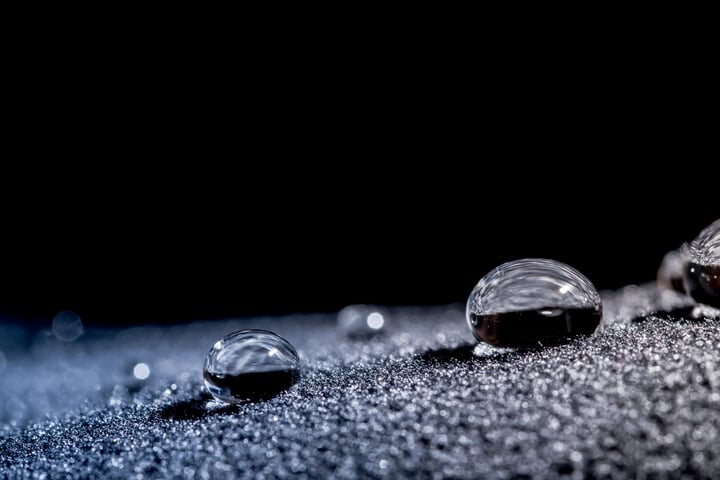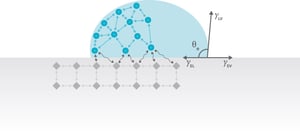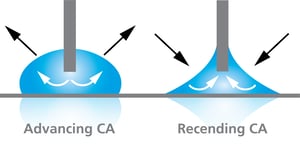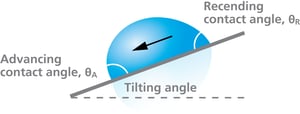
Different types of superhydrophobic, i.e. water repellent, surfaces have gained a lot of attention due to their various application possibilities. Contact angle measurements have been used to characterize these surfaces as high static contact angles (> 150°) and low contact angle hysteresis (< 10°) are decided threshold values. There are three contact angle measurement methods that can be utilized when superhydrophobic surfaces are characterized; static, advancing and receding and roll-off angle.
As by definition, one requirement for superhydrophobic is the high static contact angle, this is also commonly first measurement to do when the surface is being evaluated. In a static contact angle measurement, a stationary droplet is placed on the surface and the droplet shape is analyzed. This method is simple to understand and is the same that is most commonly used for the wettability characterization of any kind of surfaces. However, this measurement alone is not generally recommended to characterize superhydrophobic surfaces since unlike in a typical surface, the static contact angle does not necessarily show which surface has the lowest adhesion with water.
In a static contact angle measurement, a stationary droplet is placed on the surface and the droplet shape is analyzed. This method is simple to understand and is the same that is most commonly used for the wettability characterization of any kind of surfaces. However, this measurement alone is not generally recommended to characterize superhydrophobic surfaces since unlike in a typical surface, the static contact angle does not necessarily show which surface has the lowest adhesion with water.
The measurement that is getting more and more popular is the measurement of advancing and receding contact angle and contact angle hysteresis. In this measurement, the droplet is semi-dynamically expanded and contracted at the surface, giving out two separate contact angle values. With this method, we can obtain a contact angle hysteresis value, so we can evaluate tis the other requirement for superhydrophobic surface. The other benefit of this method is that the results have a very strong relation to the adhesion that we are usually interested in. However, the automation is required for this method to have enough repeatability.
In this measurement, the droplet is semi-dynamically expanded and contracted at the surface, giving out two separate contact angle values. With this method, we can obtain a contact angle hysteresis value, so we can evaluate tis the other requirement for superhydrophobic surface. The other benefit of this method is that the results have a very strong relation to the adhesion that we are usually interested in. However, the automation is required for this method to have enough repeatability.
The last method is the roll-off angle, in which a static droplet is being tilted until the droplet starts rolling on the surface. This method also relates well to adhesion. However, it is currently the least used method of the three and is less quantitative than the advancing/receding measurement since the droplet volume will have an effect on the results.
in which a static droplet is being tilted until the droplet starts rolling on the surface. This method also relates well to adhesion. However, it is currently the least used method of the three and is less quantitative than the advancing/receding measurement since the droplet volume will have an effect on the results.
To see how these measurements are done in practice, click the link below to access a short video showing all of the measurements in detailed.
Single-cell trapping can be done with the help of superhydrophobic and superhydrophilic patterns.
Advancing and receding angles should be measured as the low contact angle hysteresis is also a requirement for superhydrophobicity.
Superhydrophobic surface is defined by having the static water contact angle above 150 ° and contact angle hysteresis less than 5 °.
A self-cleaning surface is any surface with the ability to readily remove any dirt or bacteria on it. Self-cleaning surfaces can be divided into three different categories; superhydrophilic, photocatalytic and superhydrophobic.
Blood-repellent surfaces are needed in medical devices that come in contact with blood. The traditional approach has been the use of antithrombotic surface treatments However, these coatings are prone to eventually wear-off. Superhydrophobic surfaces have been proposed as an alternative solution.
With increasing understanding of the superhydrophobicity, the measurement methods to quantify the degree of hydrophobicity deserve some thought.
This video will explain two main methods for measuring dynamic contact angle.
Superhydrophobic surfaces were an instant hit in the scientific community when they were introduced over two decades ago
